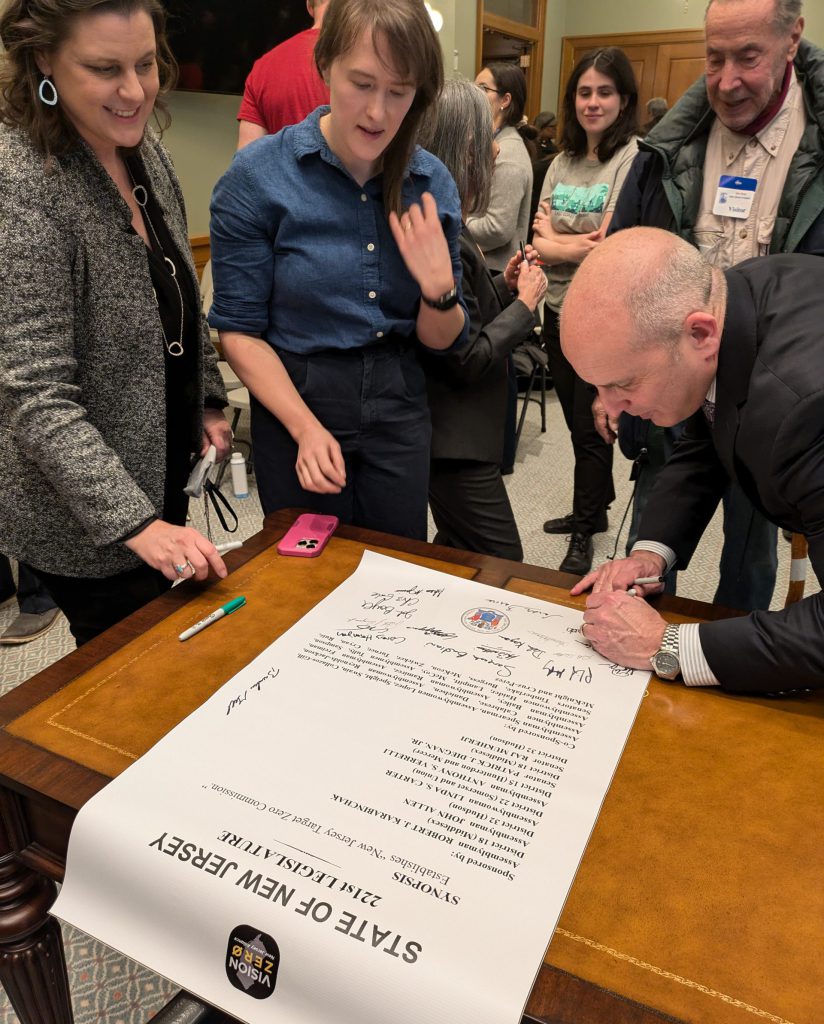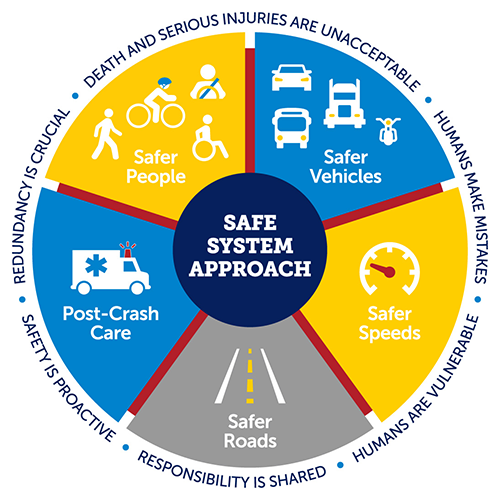In a bold step to tackle the rising number of traffic fatalities in New Jersey, Governor Murphy signed Assembly Bill 1476 on January 13th, which establishes the Target Zero Commission. Working toward a statewide goal of eliminating all traffic deaths and serious injuries by 2040, the Commission will coordinate safety efforts across ten key state agencies and New Jersey’s three Metropolitan Planning Organizations (MPOs). The Commission includes members with expertise in transportation planning and engineering, public safety and health, and advocacy, and will be led by the New Jersey Department of Transportation (NJDOT). New Jersey is one of the first states in the nation to adopt this strategy, reinforcing its commitment to improving safety for all road users.
Traffic safety continues to be a concern in New Jersey, where just 252 pedestrians and bicyclists lost their lives in 2024, according to the New Jersey State Police, who report fatal motor vehicle crash statistics. This marks a 27 percent increase compared to 2023, where there were 199 pedestrian and bicyclist fatalities. Crashes impact New Jerseyans across the state, whether it is the individuals killed or injured in the collision or their families, coworkers, and communities. These tragedies highlight the critical need to comprehensively address traffic safety and achieve the goals outlined by the Target Zero Commission.

The first step for the Commission will be to develop a statewide action plan by the end of 2025, using a multi-disciplinary and data-driven approach to develop action items that member agencies can implement in reaching the goal of zero traffic deaths. Action items may range in focus and involve different state agencies: recommendations for engineering improvements may apply to the work of NJDOT, suggestions for land use and/or zoning changes may involve agencies such as the Department of Community Affairs (NJDCA), and possible changes to enforcement practices may apply to the State Police and the Division of Highway Traffic Safety. The Commission is also charged with developing a high-injury network for the entire state, identifying the roadways with higher-than-average shares of fatal or serious crashes. The high-injury network will prioritize locations where engineering, education, and enforcement interventions are most urgent.

Source: US Department of Transportation
The Commission will use the Safe System Approach in their decision-making to advise the policies and strategies to address traffic safety. The Safe System Approach prioritizes safety for all road users using the five elements depicted in the image on the right: safer roads, safer speeds, safer vehicles, safer people, and post-crash care.
In addition to the action plan, the Commission will develop a publicly accessible crash data portal. This is an important step, as research by the Voorhees Transportation Center has documented the importance of providing accessible crash data in making targeted recommendations to improve roadway safety. Publicly available data will improve recommendations, provide transparency in the Commission’s work and increase opportunities for public engagement.
A key component of the Commission’s legislative mandate is the collaboration between state agencies, law enforcement, advocates, and local jurisdictions. The structured support and guidance from the state will help align the safety efforts of the various groups and empower local action to create a safer travel network. New Jersey’s unique transportation infrastructure needs make this type of collaboration essential to meeting the goals of the Target Zero initiative.
The Target Zero Commission’s first public hearing took place on March 6th. Commission members began by introducing themselves and identifying which agencies and MPOs they represented. Then, NJDOT staff gave a brief presentation about the Safe System Approach before the Commission opened the floor for public comment. During this comment period, private citizens and representatives from advocacy groups shared personal stories about the traffic violence that has impacted their families and communities, and many shared their hopes for what actions the Commission may take. The Target Zero Commission will provide information on future meetings, actions, resources, and opportunities as they develop.
References
Higgs, L. (2025, Jan 9). N.J. traffic deaths hit tragic 30-year high in 2024 despite nation decline. NJ.com. Retrieved from https://www.nj.com/news/2025/01/more-people-died-on-nj-roadways-last-year-grim-stats-show.html#:~:text=State%20Police%20data%20said%20the,were%20killed%20in%20550%20crashes.
Younes, H. & Noland, R. (2024). Best Practices for Improving Traffic Crash Data in New Jersey. Retrieved from https://vtc.rutgers.edu/best-practices-for-improving-traffic-crash-data-in-new-jersey/
New Jersey State Police (2025). Year to Date – Statewide Fatal Crash Statistics. Retrieved from https://www.nj.gov/njsp/info/fatalacc/2024-stats.shtml
New Jersey State Police (2024). 2024 Preliminary Fatal Motor Vehicle Crash Statistics. Retrieved from https://www.nj.gov/njsp/info/fatalacc/pdf/ptccr_24.pdf
New Jersey State Police (2023). 2023 Fatal Crash Report. Retrieved from https://www.nj.gov/njsp/information/pdf/fcr/2023_fatal_crash_report.pdf
State of New Jersey (2025, Jan 13). Governor Murphy Signs Legislation Creating Target Zero Commission. Retrieved from https://www.nj.gov/governor/news/news/562025/approved/20250113a.shtml
